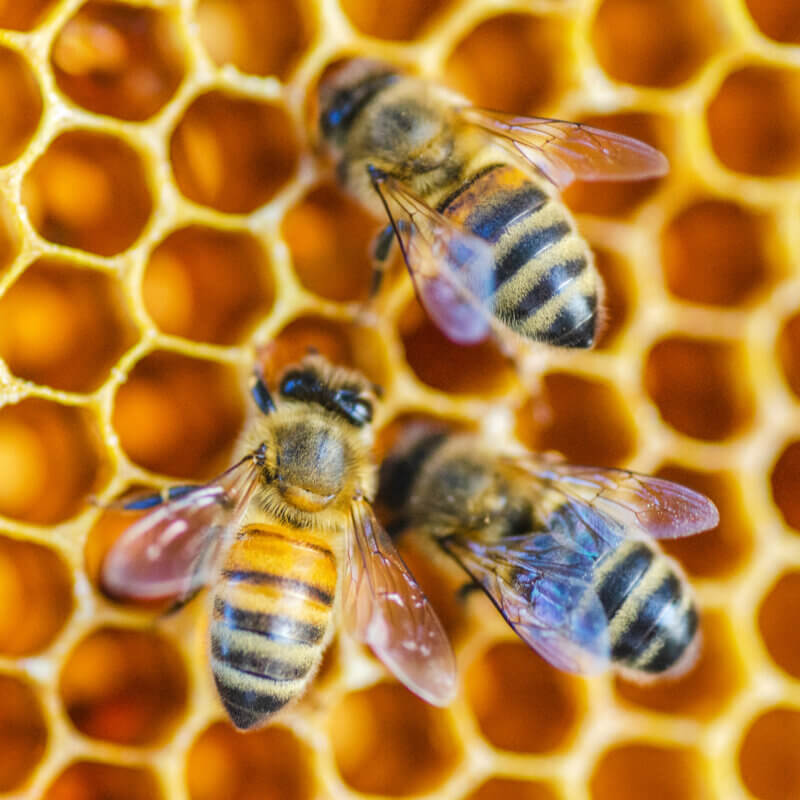Honeybees have a democracy that humans should have
This summer a swarm of honeybees set up housekeeping in the space between the screened porch ceiling and flooring of the deck above.
Fortunately, their entrance is to the outside and not into the porch or my house, so we have been quietly getting along. I don’t know how much they know about me, but I have been learning a lot about them.
I know I cannot let them stay where they are and keep expanding their hive inside the structure of the house, potentially for decades. Honeybees are our precious allies, so I want them to remain safe. But how to remove and relocate them before a black bear finds their store of honey so inviting they rip a way in? Yikes!

Thankfully, two experienced local beekeepers responded to my call for help. Later this fall, after the bees have stocked a winter’s supply of honey, we hope to cut out the section of deck floor they are probably attached to and transport the whole hive to a more permanent home elsewhere in Charlotte. Fingers crossed this works.
Meanwhile, I’ve been reading up on honeybees. Especially interesting sources are local naturalist Mary Holland’s book “Naturally Curious” and bee behavior specialist Tom Seeley’s “Honeybee Democracy.”
There are probably tens of thousands of bees living here in a dynamic cooperative family with an egg-laying queen at the center of everything. They are European honeybees (Apis mellifera), brought to North America by early colonists for honey and beeswax production. Since then, they have not only spread in the wild but are also carefully tended by countless backyard and small-scale commercial beekeepers for honey, beeswax or their unsurpassed ability to pollinate flowering plants as they collect the sweet nectar and pollen they need.
Pollination of a plant’s flowers is what makes possible the production of fruits and seeds and the next generation of those plants. It happens when a pollen grain, produced in the male part of a flower (anther), is moved to the female part (stigma), enabling the combination of their genetic material (fertilization). This can happen through self-pollination, wind and water pollination, or through the action of creatures seeking food moving within the flower and from bloom to bloom. Birds, bats, butterflies, moths, flies, beetles, wasps, small mammals, and most importantly, bees are pollinators. Honeybees are the absolute champions of pollination.
It is sobering to recognize how much depends on pollination. The natural plant and animal communities we depend on for life support, as well as at least 1,200 of our common agricultural crops would cease to exist without pollination. These include not only many fruits, vegetables and nuts which are key nutritionally to our diet, but also plants producing oils, medicines, spices, beverages, fibers and other non-edible raw materials. Pollinators are our quiet, behind the scenes, hugely important natural allies.
The primary pollinators for some 50 popular fruit and vegetable crops in this country are honeybees. While many small and medium-size farms and orchards provide homes and protection for honeybees near their crops, many large-scale operations simply bring them in as temporary workers.
Special businesses provide temporary hives of honeybees when and where needed across the country, in the number required to get a large-scale job done. According to the organization Pollinator Partnership, free honeybee labor is currently responsible for upwards of $5.4 billion in U.S. agricultural productivity annually.
But back to the honeybees at my house. Why and how did they choose to settle here? To my eye, there are many inviting tree cavities in the woods nearby, so why not there? I’ve learned that it comes down to honeybee democracy.
Each hive is a family of siblings (mostly female worker bees and some male drones who have limited roles) and a mother-queen. Although the queen’s role is powerful, she does not make all the decisions. Believe it or not, honeybees operate as a democracy.
Specialists have confirmed that a colony of tens of thousands of individuals share information primarily through movements, and function both as individuals and as one super-organism. This is observed when individual worker bees report to others the location of food sources, using a coded dance which describes direction relative to the sun and distance. Group decision-making comes into play particularly when part of the colony needs to move to a new home.
In early summer, it is not unusual for a hive to sense their quarters have become cramped or for other reasons the time is right to send the queen off with part of the colony to establish a new hive. Drones have the job of scouting the location. They travel separately for long distances across the landscape, looking for sites with the protection and food sources needed.
When a drone finds a spot that looks good, he returns to the colony and dances a report. Worker bees who are enthusiastic will repeat the dance of that individual. After several drone reports have come in, the competition gets serious. Drones assert their proposed site by dancing again, and workers vote by joining in or not. This is repeated until a clear majority of workers support the same site.
This is democracy at its best because the final decision is made by the group based on lots of relevant information gathering from many sources by many individuals, and it is considered until more than half the effected individuals are convinced to support one option. When that happens, the colony commits to the choice.
There is much more to learn about honeybees, but these two points deeply impressed and made me love even the ones inconveniently located in my porch. Honeybees make possible probably one in three bites of food I eat, and they have figured out how to make democracy work for the benefit of their whole community more smoothly than people have.

